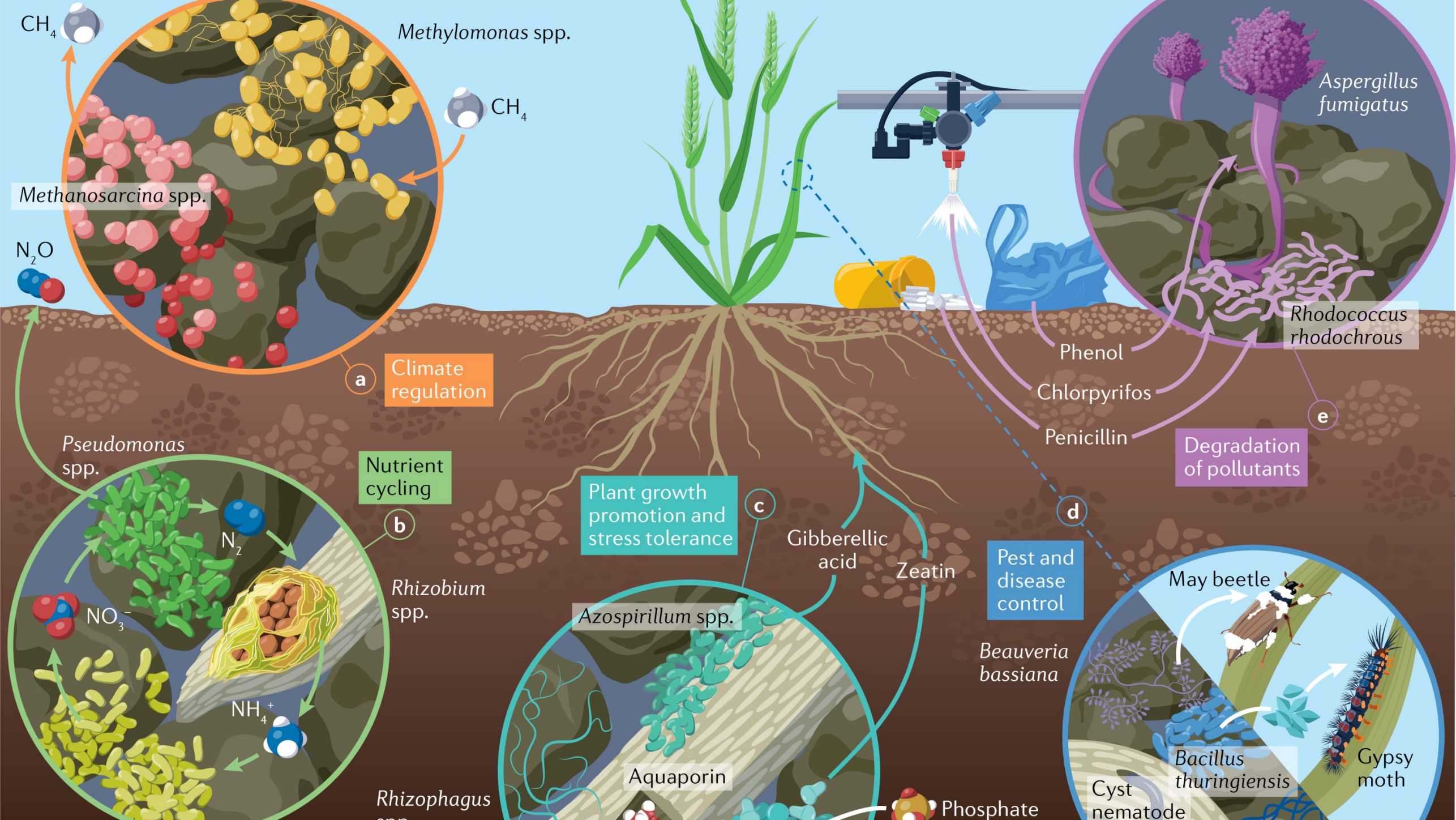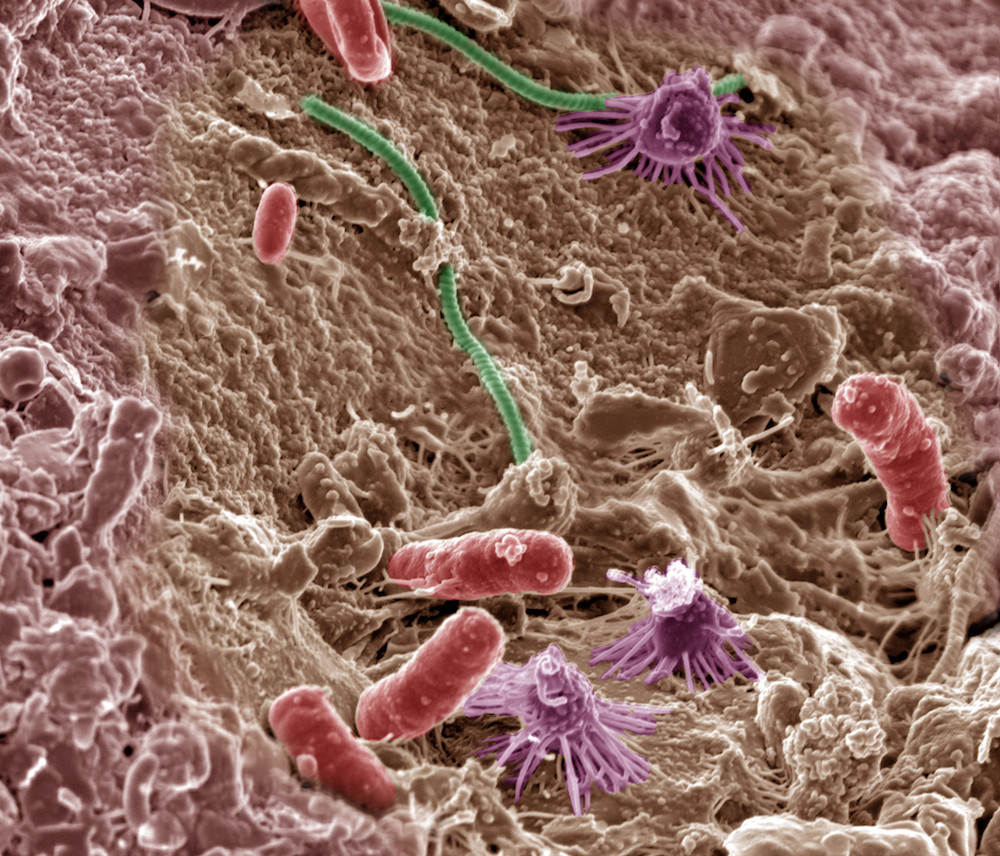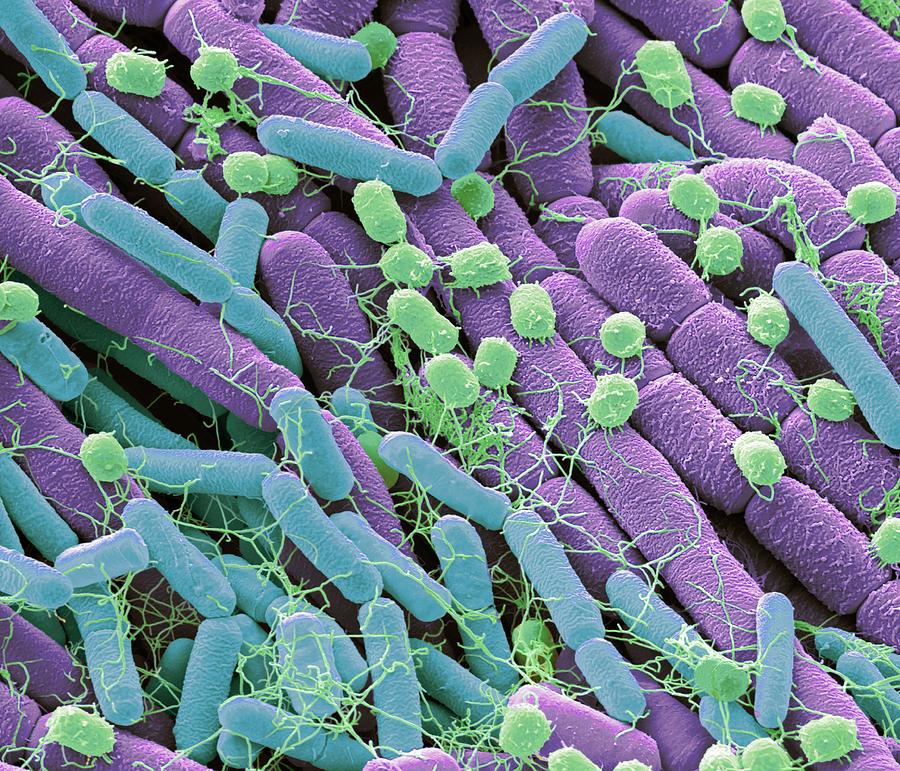When you dig into the soil, you’re stepping into a bustling world teeming with life. These invisible organisms play a crucial role in maintaining healthy soil ecosystems, and they can greatly influence plant growth and soil health. Let’s embark on a journey to uncover the secrets of soil microorganisms.
| Section | Subsection | Key Points |
|---|---|---|
| Introduction | Importance of soil microorganisms | |
| Understanding | Definition, Importance, Types | What are soil microorganisms and why are they vital? |
| Functions | Structure, Nutrients, Stability | How do they affect soil structure and fertility? |
| Biodiversity | Bacteria, Fungi, Protozoa | Diversity and roles of different soil microorganisms |
| Interactions | Symbiosis, Plant Growth | Interactions between soil microorganisms and plants |
| Environmental | Temperature, pH, Human Impact | How environmental factors affect soil microorganisms |
| Study Methods | Techniques, Molecular Tools | Methods used to study soil microorganisms |
| Enhancement | Organic Practices, Composting | Enhancing microbial diversity for better soil health |
| Management | Biofertilizers, Soil Health | Managing soil microorganisms for agricultural productivity |
| Pesticides | Impacts, Resilience | Effects of pesticides and chemical fertilizers on soil microorganisms |
| Climate Change | Carbon Sequestration, Emissions | Role of soil microorganisms in climate change mitigation |
| Urban Soils | Challenges, Green Infrastructure | Addressing urban soil issues with microbial solutions |
| Sustainability | Restoration, Policy | Integrating soil microorganisms into sustainable land management |
| Biotechnology | Bioremediation, Industrial Uses | Harnessing microorganisms for biotechnological applications |
Understanding the Microbial World
Definition of Soil Microorganisms
Soil microorganisms are tiny organisms that live in the soil and include bacteria, fungi, protozoa, and nematodes. Despite their small size, they are essential for various soil functions.
| Microorganism Type | Description | Examples |
|---|---|---|
| Bacteria | Single-celled organisms | Rhizobia, Nitrosomonas |
| Fungi | Decomposers and mutualists | Mycorrhizae, Penicillium |
| Protozoa | Microbial predators | Amoeba, Paramecium |
| Nematodes | Microscopic worms | C. elegans, Root-knot nematodes |
Importance in Soil Ecosystems
Soil microorganisms play a vital role in maintaining soil health and fertility. They decompose organic matter, cycle nutrients, and help in forming soil structure.
Key Functions:
- Decomposition of organic matter
- Nutrient cycling (e.g., nitrogen, phosphorus)
- Enhancing soil structure and stability
- Disease suppression
| Function | Role in Soil Ecosystem | Examples |
|---|---|---|
| Decomposition | Breaking down organic material | Fungi, bacteria |
| Nutrient Cycling | Recycling essential nutrients | N-fixers, P-solubilizers |
| Soil Structure | Formation and stability | Mycorrhizal fungi |
| Disease Suppression | Controlling soil-borne pathogens | Trichoderma, Bacillus |
Types of Microorganisms Found in Soil
Soil is home to diverse microorganisms, each playing unique roles. The primary types include bacteria, fungi, protozoa, and nematodes.
| Type | Function | Notable Example |
|---|---|---|
| Bacteria | Nutrient cycling, disease suppression | Rhizobium |
| Fungi | Decomposition, mutualistic relationships | Mycorrhizae |
| Protozoa | Predation on bacteria | Amoeba |
| Nematodes | Nutrient cycling, parasitism | Root-knot nematodes |

Source Image: innovationanarchy.com
Functions of Soil Microorganisms
Soil Structure and Fertility
Soil microorganisms are critical in maintaining soil structure and fertility. They produce substances that bind soil particles into aggregates, improving aeration and water retention.
| Benefit | Microbial Role | Result |
|---|---|---|
| Soil Aggregation | Producing binding agents | Improved soil structure |
| Aeration | Creating pore spaces | Enhanced root growth |
| Water Retention | Forming stable aggregates | Better moisture availability |
| Nutrient Availability | Decomposing organic matter | Release of nutrients |
Nutrient Cycling and Decomposition
Microorganisms are key players in the decomposition of organic matter, converting it into forms that plants can use. They also play a vital role in nutrient cycling, ensuring that nutrients like nitrogen, phosphorus, and sulfur are available to plants.
| Process | Description | Microbial Involvement |
|---|---|---|
| Decomposition | Breaking down organic matter | Fungi, bacteria |
| Nitrogen Cycling | N-fixation, nitrification, denitrification | Rhizobia, Nitrosomonas |
| Phosphorus Cycling | Solubilizing phosphorus | P-solubilizing bacteria |
| Sulfur Cycling | Oxidation and reduction of sulfur | Sulfate-reducing bacteria |
Soil Aggregation and Stability
Microorganisms contribute to soil aggregation by producing organic compounds that bind soil particles together, creating a stable structure that is resistant to erosion.
| Aggregate Formation | Role of Microorganisms | Benefits |
|---|---|---|
| Exopolysaccharides | Produced by bacteria and fungi | Soil particle binding |
| Hyphal Networks | Fungal mycelium | Structural stability |
| Root Exudates | Stimulate microbial activity | Enhanced aggregation |
Disease Suppression and Pest Control
Certain soil microorganisms can suppress diseases and control pests by outcompeting harmful pathogens or producing antimicrobial substances.
| Mechanism | Microbial Agent | Impact |
|---|---|---|
| Antibiosis | Production of antibiotics | Suppression of pathogens |
| Competition | Outcompeting harmful microbes | Reduced pathogen load |
| Parasitism | Attacking and killing pests | Control of soil pests |
| Induced Resistance | Triggering plant defense mechanisms | Enhanced plant immunity |

Source Image: www.no-tillfarmer.com
Biodiversity of Soil Microorganisms
Diversity Across Kingdoms
Soil hosts a vast array of microorganisms from different kingdoms, each contributing uniquely to soil health and ecosystem functioning.
| Kingdom | Examples | Roles |
|---|---|---|
| Bacteria | Rhizobia, Bacillus | Nitrogen fixation, disease suppression |
| Fungi | Mycorrhizae, Trichoderma | Nutrient absorption, decomposition |
| Protista | Amoeba, Paramecium | Predation on bacteria, nutrient cycling |
| Animalia | Nematodes, micro-arthropods | Soil aeration, organic matter breakdown |
Bacteria: The Most Abundant Microorganisms
Bacteria are the most numerous microorganisms in the soil. They play critical roles in nutrient cycling, organic matter decomposition, and disease suppression.
| Function | Bacterial Group | Example |
|---|---|---|
| Nitrogen Fixation | Rhizobia, Azotobacter | Rhizobium spp. |
| Decomposition | Actinomycetes | Streptomyces |
| Disease Suppression | Antibiotic-producing bacteria | Bacillus subtilis |
| Nutrient Solubilization | Phosphate-solubilizing bacteria | Pseudomonas |
Fungi: Decomposers and Mutualists
Fungi are vital decomposers and form mutualistic relationships with plants, aiding in nutrient absorption and improving soil structure.
| Function | Fungal Type | Example |
|---|---|---|
| Decomposition | Saprophytic fungi | Penicillium spp. |
| Mutualism | Mycorrhizal fungi | Glomus spp. |
| Disease Suppression | Antagonistic fungi | Trichoderma spp. |
| Soil Structure | Hyphal networks | Mycorrhizal fungi |
Protozoa and Nematodes: Microbial Predators
Protozoa and nematodes feed on bacteria and other microorganisms, playing a significant role in nutrient cycling and controlling microbial populations.
| Group | Role in Soil | Example |
|---|---|---|
| Protozoa | Predation on bacteria | Amoeba |
| Nematodes | Predation, nutrient cycling | C. elegans |
| Micro-arthropods | Decomposition, soil aeration | Springtails |
| Rotifers | Organic matter breakdown | Bdelloid rotifers |

Source Image: www.sciencephoto.com
Soil Microorganisms
Roles of Soil Microorganisms in Nutrient Cycling
Carbon, Nitrogen, and Phosphorus Cycling
Soil microorganisms are crucial in cycling key nutrients like carbon, nitrogen, and phosphorus, making them available for plant uptake.
| Nutrient | Microbial Role | Process |
|---|---|---|
| Carbon | Decomposition of organic matter | CO2 release, humus formation |
| Nitrogen | N-fixation, nitrification, denitrification | Conversion to plant-available forms |
| Phosphorus | Solubilization, mineralization | Release from soil minerals |
Mineralization and Immobilization Processes
Microorganisms mineralize organic matter, releasing nutrients in inorganic forms that plants can absorb. They also immobilize nutrients, storing them in biomass.
| Process | Description | Microbial Involvement |
|---|---|---|
| Mineralization | Conversion of organic to inorganic forms | Decomposers |
| Immobilization | Uptake and storage in microbial biomass | Fungi, bacteria |
Symbiotic Relationships with Plants
Microorganisms form symbiotic relationships with plants, such as mycorrhizal associations and nitrogen-fixing symbioses, enhancing nutrient uptake and plant growth.
| Symbiosis Type | Microbial Partner | Benefit to Plants |
|---|---|---|
| Mycorrhizal | Fungi (e.g., Glomus spp.) | Enhanced nutrient absorption |
| Nitrogen-Fixing | Bacteria (e.g., Rhizobium spp.) | Nitrogen supply |
| PGPR | Rhizobacteria | Growth promotion, disease resistance |
Impact on Soil pH and Nutrient Availability
Microorganisms can alter soil pH through their metabolic activities, influencing nutrient availability for plants.
| Activity | Effect on pH | Result |
|---|---|---|
| Organic Acid Production | Lowering pH | Increased nutrient solubility |
| Ammonification | Raising pH | Enhanced nitrification |
| Sulfur Oxidation | Lowering pH | Improved sulfur availability |

Source Image: usys.ethz.ch
Interactions Between Soil Microorganisms and Plants
Mutualistic Relationships
Many soil microorganisms form mutually beneficial relationships with plants, helping them absorb nutrients and resist diseases.
| Relationship Type | Microbial Partner | Benefit to Plants |
|---|---|---|
| Mycorrhizal | Fungi (e.g., Glomus spp.) | Enhanced nutrient uptake |
| Rhizobial | Bacteria (e.g., Rhizobium spp.) | Nitrogen fixation |
| PGPR | Rhizobacteria (e.g., Bacillus spp.) | Growth promotion, disease suppression |
Mycorrhizal Associations
Mycorrhizal fungi form associations with plant roots, extending their root system and increasing their access to nutrients and water.
| Mycorrhizal Type | Description | Example |
|---|---|---|
| Arbuscular Mycorrhizae | Intracellular symbiosis | Glomus spp. |
| Ectomycorrhizae | Extracellular symbiosis | Pisolithus spp. |
| Ericoid Mycorrhizae | Symbiosis with ericaceous plants | Rhizoscyphus spp. |
Nitrogen-Fixing Symbiosis
Nitrogen-fixing bacteria form symbiotic relationships with legumes and other plants, converting atmospheric nitrogen into forms that plants can use.
| Symbiotic Partner | Plant Type | Example |
|---|---|---|
| Rhizobia | Legumes | Rhizobium spp. |
| Frankia | Non-leguminous plants | Frankia spp. |
| Cyanobacteria | Aquatic plants | Anabaena spp. |
Plant Growth-Promoting Rhizobacteria (PGPR)
PGPR colonize plant roots and promote growth by producing phytohormones, solubilizing nutrients, and protecting against pathogens.
| Mechanism | Description | Example |
|---|---|---|
| Phytohormone Production | Synthesis of growth hormones | Bacillus spp. |
| Nutrient Solubilization | Making nutrients available | Pseudomonas spp. |
| Pathogen Suppression | Antagonism towards pathogens | Trichoderma spp. |

Source Image: www.nmhealthysoil.org
Influence of Environmental Factors on Soil Microorganisms
Temperature and Moisture Effects
Soil temperature and moisture levels significantly affect microbial activity and community composition.
| Factor | Effect on Microorganisms | Optimal Range |
|---|---|---|
| Temperature | Influences metabolic rates | 20-30°C (68-86°F) |
| Moisture | Affects microbial respiration | 50-70% of field capacity |
pH Levels and Soil Acidity
Soil pH affects the availability of nutrients and the activity of different microorganisms.
| pH Range | Microbial Activity | Example Organisms |
|---|---|---|
| Acidic (pH < 6) | Fungi dominant | Penicillium spp. |
| Neutral (pH 6-7) | Balanced microbial activity | Rhizobia, Mycorrhizae |
| Alkaline (pH > 7) | Actinomycetes dominant | Streptomyces spp. |
Organic Matter Inputs
Organic matter serves as a food source for soil microorganisms, influencing their activity and diversity.
| Organic Input | Effect on Microorganisms | Example |
|---|---|---|
| Compost | Increases microbial biomass | Diverse microbial communities |
| Green Manure | Enhances nutrient cycling | Rhizobacteria |
| Crop Residues | Provides habitat and nutrients | Decomposers |
Human Activities and Soil Disturbances
Human activities such as agriculture, deforestation, and urbanization can impact soil microbial communities and their functions.
| Activity | Impact on Soil Microorganisms | Mitigation Strategies |
|---|---|---|
| Tillage | Disrupts soil structure | Reduced tillage |
| Chemical Fertilizers | Alters microbial balance | Organic amendments |
| Pesticides | Harmful to beneficial microbes | Integrated pest management |
Methods for Studying Soil Microorganisms
Microscopy and Cultivation Techniques
Traditional methods like microscopy and cultivation are used to observe and grow soil microorganisms in the lab.
| Technique | Description | Limitation |
|---|---|---|
| Microscopy | Direct observation of microbes | Limited resolution |
| Cultivation | Growing microbes on media | Only culturable species |
Molecular Biology Tools
Modern molecular tools allow for the identification and characterization of soil microorganisms without the need for cultivation.
| Tool | Application | Advantage |
|---|---|---|
| PCR (Polymerase Chain Reaction) | Amplification of microbial DNA | High sensitivity |
| DNA Sequencing | Identifying microbial communities | Comprehensive analysis |
Next-Generation Sequencing
Next-generation sequencing (NGS) provides a high-throughput method to analyze microbial communities and their functions.
| Technology | Description | Benefit |
|---|---|---|
| Metagenomics | Sequencing of entire microbial communities | Broad insights into microbial diversity |
| Transcriptomics | Sequencing of RNA to study gene expression | Functional insights |
Metagenomics and Metatranscriptomics
These advanced techniques offer detailed insights into the genetic and functional diversity of soil microorganisms.
| Technique | Focus | Application |
|---|---|---|
| Metagenomics | DNA from environmental samples | Microbial diversity analysis |
| Metatranscriptomics | RNA from environmental samples | Functional activity analysis |

Source Image: universe-review.ca
Soil Microorganisms
Enhancing Soil Microbial Diversity
Organic Farming Practices
Organic farming promotes soil health and microbial diversity through the use of natural inputs and sustainable practices.
| Practice | Benefit to Microbes | Example |
|---|---|---|
| Organic Amendments | Increases microbial biomass | Compost, manure |
| Cover Cropping | Enhances soil organic matter | Legumes, grasses |
| Crop Rotation | Reduces pathogen buildup | Diverse crop species |
Cover Cropping and Crop Rotation
Cover cropping and crop rotation are practices that support diverse and healthy microbial communities in the soil.
| Practice | Benefit | Example Crops |
|---|---|---|
| Cover Cropping | Adds organic matter, reduces erosion | Clover, rye |
| Crop Rotation | Prevents disease buildup | Corn-soybean rotation |
Reduced Tillage and Soil Disturbance
Minimizing soil disturbance helps maintain soil structure and supports microbial activity.
| Practice | Benefit | Example |
|---|---|---|
| No-till Farming | Preserves soil structure | Direct seeding |
| Minimal Tillage | Reduces soil compaction | Strip tillage |
Composting and Organic Amendments
Adding compost and other organic amendments boosts soil fertility and microbial diversity.
| Amendment | Benefit to Soil | Example |
|---|---|---|
| Compost | Increases microbial biomass | Yard waste compost |
| Organic Mulch | Provides habitat for microbes | Wood chips |
Managing Soil Microorganisms for Agricultural Productivity
Biofertilizers and Soil Inoculants
Biofertilizers and soil inoculants introduce beneficial microorganisms to the soil, enhancing nutrient availability and plant growth.
| Product | Microbial Component | Benefit |
|---|---|---|
| Rhizobium Inoculants | Nitrogen-fixing bacteria | Improved nitrogen supply |
| Mycorrhizal Inoculants | Symbiotic fungi | Enhanced nutrient uptake |
| PGPR Formulations | Plant growth-promoting rhizobacteria | Growth stimulation |
Microbial Consortia Applications
Using consortia of microorganisms can enhance soil health and productivity by combining different beneficial effects.
| Consortium | Components | Application |
|---|---|---|
| Rhizobia and Mycorrhizae | Bacteria and fungi | Legume crop inoculation |
| PGPR Mix | Multiple beneficial bacteria | General crop enhancement |
Integrating Microbial Biostimulants
Microbial biostimulants can boost plant growth, improve nutrient uptake, and enhance stress resistance.
| Biostimulant Type | Description | Example |
|---|---|---|
| Bacterial Biostimulants | Enhance nutrient uptake | Azospirillum |
| Fungal Biostimulants | Improve root health | Trichoderma |
Soil Microbial Health Assessments
Regular assessments of soil microbial health can guide management practices to enhance soil fertility and crop productivity.
| Assessment Method | Purpose | Example Parameters |
|---|---|---|
| Soil Respiration | Measure microbial activity | CO2 production |
| Microbial Biomass | Estimate microbial population | Biomass C, N |

Source Image: pixels.com
Impacts of Pesticides and Chemical Fertilizers on Soil Microorganisms
Pesticide Residues and Microbial Communities
Pesticide residues can harm beneficial soil microorganisms, disrupting ecological balance and soil health.
| Pesticide Type | Impact on Microbes | Mitigation Strategy |
|---|---|---|
| Herbicides | Reduced microbial diversity | Integrated pest management |
| Insecticides | Harm to beneficial insects | Biological control methods |
Nitrification Inhibition and Nitrogen Loss
Chemical fertilizers can inhibit nitrification, leading to nitrogen loss and reduced soil fertility.
| Fertilizer Type | Impact on Microbes | Mitigation Strategy |
|---|---|---|
| Nitrate Fertilizers | Inhibit nitrification | Use of nitrification inhibitors |
| Ammonium Fertilizers | Alter microbial balance | Slow-release fertilizers |
Soil Microbial Resilience and Recovery
Soil microbial communities can recover from pesticide and fertilizer impacts over time, especially with organic management practices.
| Recovery Factor | Description | Example |
|---|---|---|
| Organic Matter Input | Enhances microbial resilience | Compost application |
| Reduced Chemical Use | Lowers stress on microbes | Organic farming |
Alternatives to Chemical Inputs
Using organic alternatives to chemical fertilizers and pesticides can support healthy soil microbial communities.
| Alternative | Benefit to Soil Microbes | Example |
|---|---|---|
| Organic Fertilizers | Enhance microbial activity | Manure, compost |
| Biopesticides | Target specific pests | Neem oil, Bt |
Soil Microorganisms in Climate Change Mitigation
Carbon Sequestration Potential
Soil microorganisms play a key role in carbon sequestration, helping to mitigate climate change by storing carbon in soil organic matter.
| Process | Microbial Role | Climate Benefit |
|---|---|---|
| Carbon Fixation | Conversion of CO2 to organic matter | Reduced atmospheric CO2 |
| Humification | Stabilization of organic matter | Long-term carbon storage |
Methane and Nitrous Oxide Emissions
Microbial processes can influence the emission of greenhouse gases like methane and nitrous oxide from soils.
| Gas | Microbial Process | Impact |
|---|---|---|
| Methane | Methanogenesis, methanotrophy | CH4 emission reduction |
| Nitrous Oxide | Nitrification, denitrification | N2O emission reduction |
Microbial Contributions to Soil Health
Healthy microbial communities enhance soil structure, nutrient cycling, and plant growth, contributing to overall soil health.
| Contribution | Description | Example Microbes |
|---|---|---|
| Soil Structure | Formation of stable aggregates | Mycorrhizae, bacteria |
| Nutrient Cycling | Decomposition and mineralization | Decomposers, N-fixers |
Adaptation Strategies for Changing Climates
Microbial management practices can help soils adapt to changing climatic conditions, improving resilience and productivity.
| Strategy | Benefit | Example |
|---|---|---|
| Organic Amendments | Improve soil water retention | Compost, biochar |
| Cover Cropping | Protect soil from erosion | Legumes, grasses |
Urban Soil Microorganisms
Challenges of Urban Soil Environments
Urban soils face unique challenges such as compaction, pollution, and reduced organic matter, affecting microbial communities.
| Challenge | Impact on Microbes | Mitigation Strategy |
|---|---|---|
| Compaction | Reduced aeration and root growth | Soil aeration practices |
| Pollution | Toxic effects on microbes | Phytoremediation |
Soil Remediation Techniques
Various techniques can be used to remediate contaminated urban soils, enhancing microbial activity and soil health.
| Technique | Description | Application |
|---|---|---|
| Phytoremediation | Use of plants to remove contaminants | Willow, poplar |
| Bioremediation | Use of microbes to degrade pollutants | Hydrocarbon-degrading bacteria |
Green Infrastructure and Urban Agriculture
Incorporating green infrastructure and promoting urban agriculture can improve soil health and microbial diversity in cities.
| Practice | Benefit | Example |
|---|---|---|
| Green Roofs | Improve urban biodiversity | Sedum species |
| Community Gardens | Enhance soil organic matter | Mixed vegetables |
Community Engagement and Education
Engaging communities in soil health initiatives can foster sustainable urban environments and improve soil management practices.
| Initiative | Benefit | Example |
|---|---|---|
| Urban Farming Workshops | Educate on sustainable practices | Composting workshops |
| Soil Health Campaigns | Raise awareness on soil importance | Local community events |
Soil Microorganisms in Sustainable Land Management
Role in Ecosystem Restoration
Soil microorganisms play a crucial role in ecosystem restoration by enhancing soil health and supporting plant growth.
| Restoration Activity | Microbial Role | Example |
|---|---|---|
| Reforestation | Mycorrhizal symbiosis | Reintroduction of native trees |
| Wetland Restoration | Decomposition of organic matter | Wetland microbial communities |
Soil Bioremediation Applications
Microorganisms can be used to clean up contaminated soils through bioremediation, breaking down pollutants into less harmful substances.
| Pollutant | Microbial Solution | Example Microbe |
|---|---|---|
| Hydrocarbons | Degradation by bacteria | Pseudomonas spp. |
| Heavy Metals | Bioaccumulation by fungi | Aspergillus spp. |
Integrating Microbial Approaches into Agroecology
Incorporating microbial approaches into agroecological practices can enhance soil health, biodiversity, and sustainability.
| Practice | Microbial Contribution | Example |
|---|---|---|
| Agroforestry | Enhanced nutrient cycling | Mycorrhizal fungi |
| Polyculture | Increased microbial diversity | Diverse crop species |
Policy Implications and Future Directions
Policies promoting sustainable soil management and microbial health are essential for long-term agricultural productivity and ecosystem stability.
| Policy | Focus | Example |
|---|---|---|
| Organic Farming | Reducing chemical inputs | Certification programs |
| Soil Health Legislation | Protecting soil ecosystems | Conservation initiatives |
Harnessing Soil Microorganisms for Biotechnological Applications
Bioremediation of Polluted Soils
Microorganisms can be employed in bioremediation to degrade pollutants and restore soil health.
| Pollutant | Microbial Solution | Example Organism |
|---|---|---|
| Petroleum Hydrocarbons | Biodegradation by bacteria | Pseudomonas spp. |
| Pesticides | Degradation by fungi | White-rot fungi |
Biofuel Production and Bioplastics
Soil microorganisms can be harnessed to produce biofuels and bioplastics, offering sustainable alternatives to fossil fuels and plastics.
| Product | Microbial Role | Example Microbe |
|---|---|---|
| Biofuels | Fermentation of biomass | Yeasts, bacteria |
| Bioplastics | Production from renewable resources | PHA-producing bacteria |
Pharmaceutical and Industrial Uses
Microorganisms from soil are sources of novel pharmaceuticals and industrial enzymes, contributing to medical and industrial advancements.
| Application | Microbial Product | Example |
|---|---|---|
| Antibiotics | Production from soil bacteria | Streptomyces spp. |
| Enzymes | Industrial applications | Bacillus spp. |
Research Frontiers in Soil Microbial Biotechnology
Ongoing research in soil microbial biotechnology is uncovering new applications and enhancing our understanding of soil microorganisms, paving the way for innovative solutions to environmental and agricultural challenges.
| Research Area | Focus | Example Applications |
|---|---|---|
| Microbial Ecology | Community dynamics and interactions | Soil health monitoring |
| Functional Genomics | Gene functions and expression | Bioremediation optimization |
| Synthetic Biology | Engineering microbial systems | Designer soil inoculants |
Exploring these frontiers can lead to breakthroughs in sustainable agriculture, environmental remediation, and biotechnological innovation, harnessing the power of soil microorganisms for the benefit of society.
Soil microorganisms are the hidden champions of terrestrial ecosystems, driving essential processes that sustain life on Earth. From nutrient cycling to plant growth promotion, these tiny organisms play diverse and vital roles in soil health and productivity. Understanding their functions, interactions, and responses to environmental changes is crucial for developing sustainable land management practices and mitigating the impacts of climate change.
By harnessing the power of soil microorganisms through organic farming, biodiversity conservation, and biotechnological innovations, we can cultivate healthier soils, increase agricultural productivity, and promote environmental resilience. However, achieving these goals requires concerted efforts from researchers, policymakers, farmers, and communities to prioritize soil health and microbial diversity in land management practices.
As we delve deeper into the microbial world beneath our feet, we uncover new opportunities to unlock the full potential of soil ecosystems for the benefit of present and future generations. By nurturing soil microorganisms, we cultivate not only the foundation of agriculture but also the roots of sustainable development and planetary stewardship.
In conclusion, soil microorganisms may be small in size, but their impact on the health and vitality of ecosystems is immense. Let us continue to explore, innovate, and collaborate in our quest to unlock the secrets of the soil and harness its microbial treasures for a more resilient and sustainable future.

